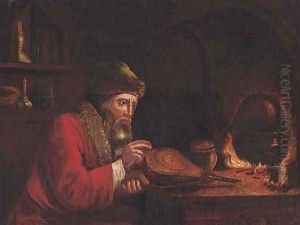Christopher Paudiss Paintings
Christopher Paudiss, also known as Christoph Paudiss, was a Baroque era painter born in 1630 in either Satu Mare, which is today part of Romania, or in Frankfurt am Main, which is now in Germany. The uncertainty surrounding his birthplace is indicative of the sparse documentation of his early life. Despite this, Paudiss is recognized for his contributions to the art world, particularly in the genre of portraiture and still-life painting.
Paudiss initially trained in the workshop of Rembrandt van Rijn in Amsterdam. The influence of Rembrandt is evident in Paudiss' work, particularly in his use of chiaroscuro and the psychological depth he brought to his subjects. His style is characterized by a strong attention to detail and a preference for warm, rich colors.
After his period in the Netherlands, Paudiss worked in several regions, including Hamburg and Vienna, where he was influenced by local artistic styles and contributed to the cultural milieu. His work during this time diversified, showing not only his skill in portraiture but also in religious and mythological scenes, as well as landscape painting.
Unfortunately, Paudiss' career was cut short when he died in 1666. Although he was active as an artist for only a relatively brief period, his work has been appreciated for its technical skill and emotional resonance. Paudiss' legacy is that of a talented painter who incorporated the lessons of the Dutch master Rembrandt and adapted them within his own unique artistic vision. His paintings are now considered valuable examples of the Baroque period and can be found in various museums and collections across Europe, though he is not as widely recognized as some of his contemporaries.
